Stability or Change?
What happens to our intellectual muscles as we age? Do they gradually decline, as does our body strength? Or do they remain constant? To see how psychologists have studied intelligence, see Thinking Critically About: Cross-Sectional and Longitudinal Studies. The quest for answers to these questions illustrates psychology’s self-correcting process.
Aging and Intelligence
 Flip It Video: Fluid & Crystallized Intelligence
Flip It Video: Fluid & Crystallized Intelligence
With the results of cross-sectional studies showing that older adults give fewer correct answers on intelligence tests than do younger adults, WAIS-creator David Wechsler (1972) concluded that “the decline of mental ability with age is part of the general [aging] process of the organism as a whole.” For a long time, this rather dismal view went unchallenged. Many corporations established mandatory retirement policies, assuming the companies would benefit by replacing aging workers with younger, more capable employees. As the saying goes, you can’t teach an old dog new tricks.
After colleges in the 1920s began giving intelligence tests to entering students, several psychologists saw their chance to study intelligence longitudinally. They retested the same cohort—the same group of people—over a period of years (Schaie & Geiwitz, 1982). What they found was a surprise: Until late in life, intelligence remained stable. On some tests, scores even increased, due partly to experience with the tests (Salthouse, 2014) (Figure 62.1).
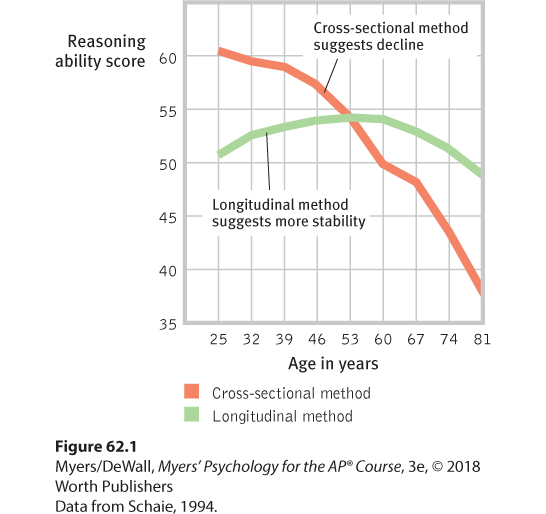
Figure 62.1 Cross-sectional versus longitudinal testing of intelligence at various ages
In this test of one type of verbal intelligence (inductive reasoning), the cross-sectional method showed declining scores with age. The longitudinal method (in which the same people were retested over a period of years) showed a slight rise in scores well into adulthood.
The more optimistic results from longitudinal studies challenged the presumption that intelligence sharply declines with age. Famed painter Anna Mary Robertson Moses (“Grandma Moses”) took up painting in her seventies, and at age 88 a popular magazine named her “Young Woman of the Year.” At age 89, architect Frank Lloyd Wright designed New York City’s Guggenheim Museum. As the saying goes, you’re never too old to learn.
So the answers to our age-and-intelligence questions depend on what we assess and how we assess it. Crystallized intelligence—our accumulated knowledge as reflected in vocabulary and analogies tests—increases up to old age. Fluid intelligence—our ability to reason speedily and abstractly, as when solving novel logic problems—decreases beginning in the twenties and thirties, slowly up to age 75 or so, then more rapidly, especially after age 85 (Deary & Ritchie, 2016; Horn, 1982; Salthouse, 2009; 2013). With age, we lose and we win. We lose recall memory and processing speed, but we gain vocabulary and knowledge (Ackerman, 2014; Figure 62.2). Fluid intelligence may decline, but older adults’ social reasoning skills increase, as shown by an ability to take multiple perspectives, to appreciate knowledge limits, and to offer helpful wisdom in times of social conflict (Grossmann et al., 2010). Decisions also become less distorted by negative emotions such as anxiety, depression, and anger (Blanchard-Fields, 2007; Carstensen & Mikels, 2005).
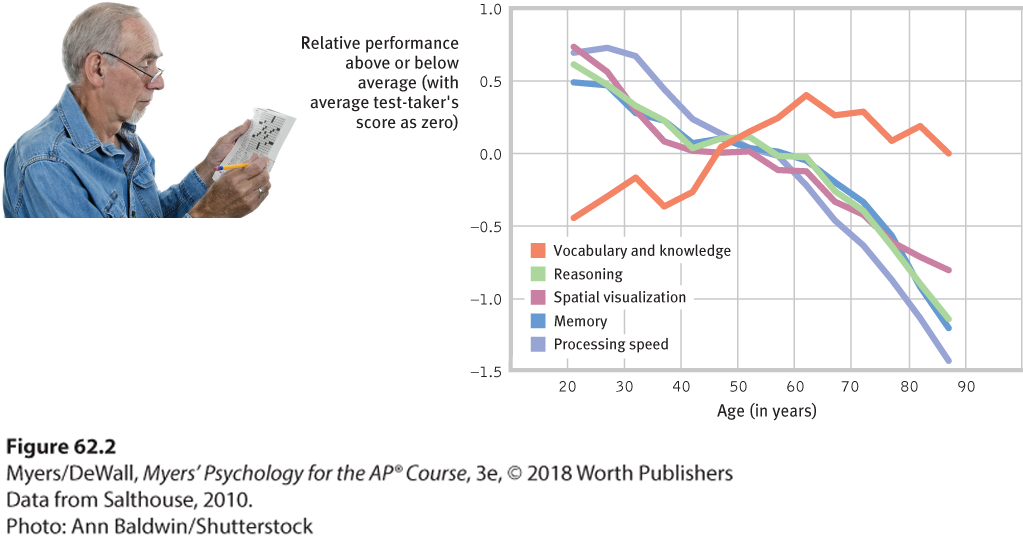
Figure 62.2 With age, we lose and we win
Studies reveal that word power grows with age, while fluid intelligence declines.
“ Knowledge is knowing a tomato is a fruit; wisdom is not putting it in a fruit salad.”
Anonymous
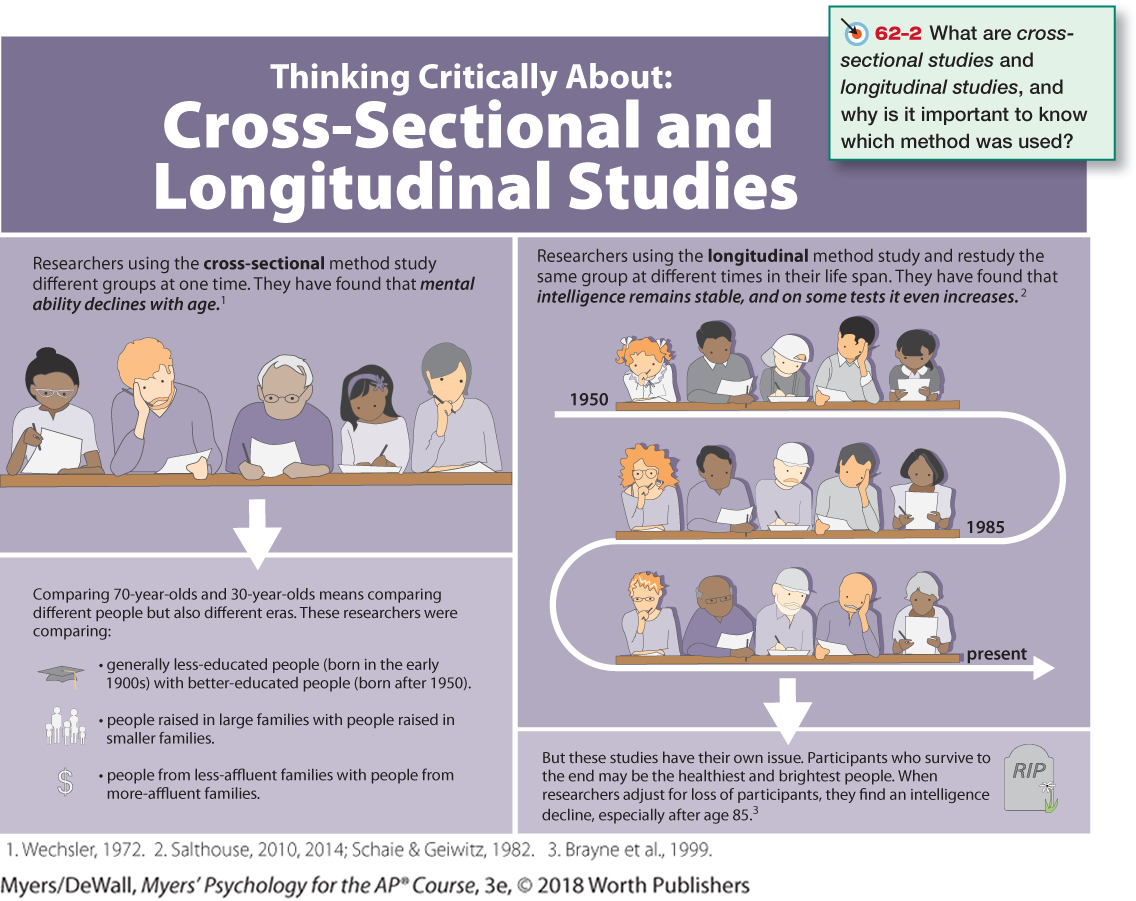
Age-related cognitive differences help explain why older adults are less likely to embrace new technologies (Charness & Boot, 2009; Pew, 2017). These cognitive differences also help explain why mathematicians and scientists produce much of their most creative work during their late twenties or early thirties, when fluid intelligence is at its peak (Jones et al., 2014). In contrast, authors, historians, and philosophers tend to produce their best work in their forties, fifties, and beyond—after accumulating more knowledge (Simonton, 1988, 1990). Poets, for example, who depend on fluid intelligence, reach their peak output earlier than prose authors, who need the deeper knowledge reservoir that accumulates with age. This finding holds across literary traditions, for both living and dead languages.
Stability Over the Life Span
What about the stability of early-life intelligence scores? For most children, casual observation and intelligence tests before age 3 only modestly predict their future aptitudes (Humphreys & Davey, 1988; Tasbihsazan et al., 2003). Even Albert Einstein was once thought “slow”—as he was in learning to talk (Quasha, 1980).
“ In youth we learn, in age we understand.”
Marie Von Ebner-Eschenbach, Aphorisms, 1883
By age 4, however, children’s performance on intelligence tests begins to predict their adolescent and adult scores. The consistency of scores over time increases with the age of the child (Tucker-Drob & Briley, 2014). By age 11, the stability becomes impressive, as Ian Deary and his colleagues (2004, 2009b, 2013) discovered. Their amazing longitudinal studies have been enabled by their country, Scotland, doing something that no nation has done before or since. On June 1, 1932, essentially every child in the country born in 1921—87,498 children around age 11—took an intelligence test. The aim was to identify working-class children who would benefit from further education. Sixty-five years later to the day, Patricia Whalley, the wife of Deary’s co-worker, Lawrence Whalley, discovered the test results on dusty storeroom shelves at the Scottish Council for Research in Education, not far from Deary’s Edinburgh University office. “This will change our lives,” Deary replied when Whalley told him the news.
“ My dear Adele, I am 4 years old and I can read any English book. I can say all the Latin substantives and adjectives and active verbs besides 52 lines of Latin poetry.”
Francis Galton, letter to his sister, 1827
And so it has, with dozens of studies of the stability and the predictive capacity of these early test results. For example, when the intelligence test administered to 11-year-old Scots in 1932 was readministered to 542 survivors as turn-of-the-millennium 80-year-olds, the correlation between the two sets of scores—after nearly 70 years of varied life experiences—was striking (Figure 62.3). Ditto when 106 survivors were retested at age 90 (Deary et al., 2013). Another study that followed Scots born in 1936 from ages 11 to 70 confirmed the remarkable stability of intelligence, independent of life circumstance (Johnson et al., 2010).
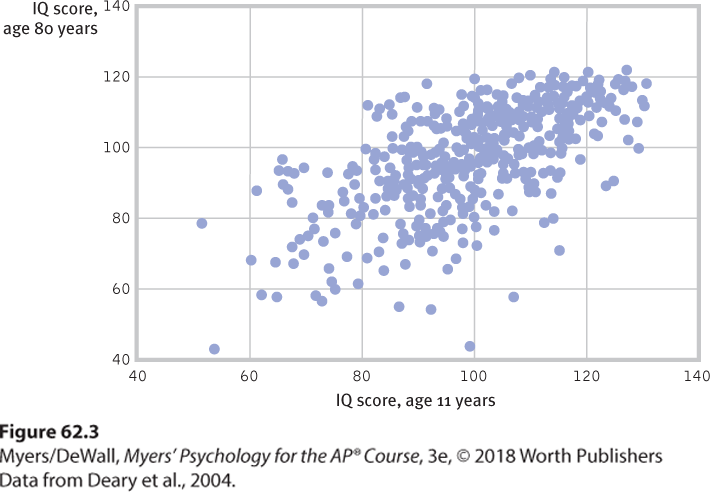
Figure 62.3 Intelligence endures
When Ian Deary and his colleagues retested 80-year-old Scots using an intelligence test they had taken as 11-year-olds, their scores across seven decades correlated +0.66, as shown here. When 106 survivors were again retested at age 90, the correlation with their age 11 scores was +0.54 (Deary et al., 2013).
Children and adults who are more intelligent also tend to live healthier and longer lives (Figure 62.4). Why might this be the case? Deary (2008) reports four possible explanations:
- Intelligence facilitates more education, better jobs, and a healthier environment.
- Intelligence encourages healthy living: less smoking, better diet, more exercise.
- Prenatal events or early childhood illnesses might have influenced both intelligence and health.
- A “well-wired body,” as evidenced by fast reaction speeds, perhaps fosters both intelligence and longevity. (Intelligent people tend to be literally quick-witted—to perceive and respond to stimuli quickly.)
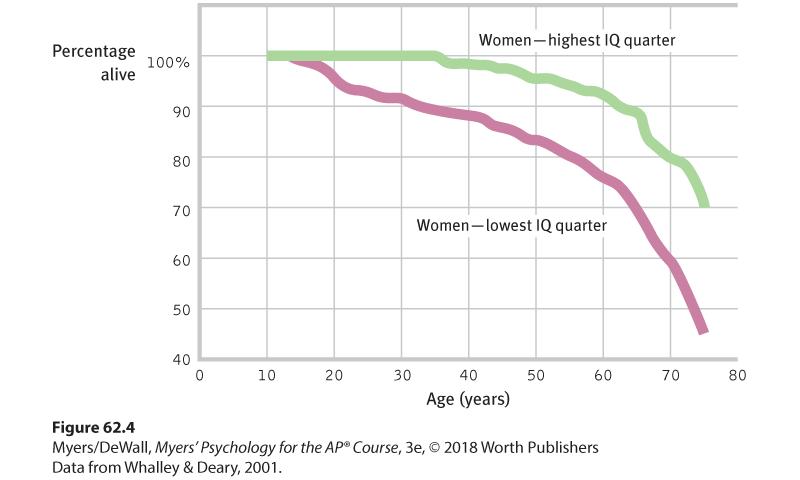
Figure 62.4 Living smart
Women scoring in the highest 25 percent on the Scottish national intelligence test at age 11 tended to live longer than those who scored in the lowest 25 percent.
“ Whether you live to collect your old-age pension depends in part on your IQ at age 11.”
Ian Deary, “Intelligence, Health, and Death,” 2005